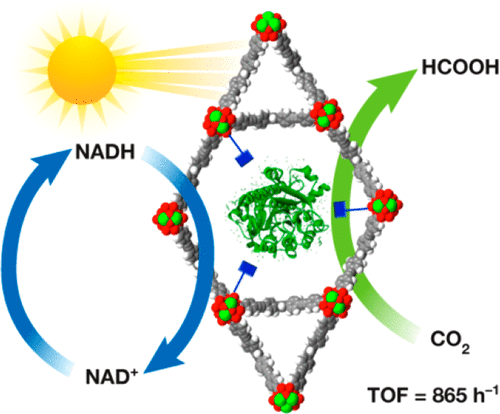当前位置:
X-MOL 学术
›
J. Am. Chem. Soc.
›
论文详情
Our official English website, www.x-mol.net, welcomes your feedback! (Note: you will need to create a separate account there.)
Integration of Enzymes and Photosensitizers in a Hierarchical Meso- porous Metal–Organic Framework for Light-Driven CO2 Reduction
Journal of the American Chemical Society ( IF 15.0 ) Pub Date : 2020-01-13 , DOI: 10.1021/jacs.9b12828 Yijing Chen 1, 2 , Peng Li 1, 2 , Jiawang Zhou 1 , Cassandra T Buru 1 , Luka Đorđević 1 , Penghao Li 1 , Xuan Zhang 1 , M Mustafa Cetin 1 , J Fraser Stoddart 1, 3, 4 , Samuel I Stupp 1, 5 , Michael R Wasielewski 1, 2, 6 , Omar K Farha 1, 2, 6, 7
Journal of the American Chemical Society ( IF 15.0 ) Pub Date : 2020-01-13 , DOI: 10.1021/jacs.9b12828 Yijing Chen 1, 2 , Peng Li 1, 2 , Jiawang Zhou 1 , Cassandra T Buru 1 , Luka Đorđević 1 , Penghao Li 1 , Xuan Zhang 1 , M Mustafa Cetin 1 , J Fraser Stoddart 1, 3, 4 , Samuel I Stupp 1, 5 , Michael R Wasielewski 1, 2, 6 , Omar K Farha 1, 2, 6, 7
Affiliation

|
Protection of enzymes with synthetic materials is a viable strategy to stabilize, and hence to retain, the reactivity of these highly active biomolecules in non-native environments. Active synthetic supports, coupled to encapsulated enzymes, can enable efficient cascade reactions which are necessary for processes like light-driven CO2 reduction, providing a promising pathway for alternative energy generation. Herein, a semi- artificial system - containing an immobilized enzyme, formate dehydrogenase, in a light harvesting scaffold - is reported for the conversion of CO2 to formic acid using white light. The electron-mediator Cp*Rh(2,2'-bipyridyl-5,5'-dicarboxylic acid)Cl2 was anchored to the nodes of the metal-organic framework NU- 1006 to facilitate ultrafast photo-induced electron transfer when irradiated, leading to the reduction of the coenzyme nicotinamide adenine dinucleotide at a rate of about 28 mM h-1. Most importantly of all, the immobilized enzyme utilizes the reduced coenzyme to generate formic acid selectively from CO2 at a high turnover frequency of about 865 h-1 in 24 hours. The outcome of this research is the demonstration of a feasible pathway for solar-driven carbon fixation.
中文翻译:

酶和光敏剂在用于光驱动 CO2 还原的分层介孔金属-有机框架中的整合
用合成材料保护酶是稳定并因此保持这些高活性生物分子在非天然环境中的反应性的可行策略。活性合成载体与封装酶结合,可以实现高效的级联反应,这是光驱动二氧化碳还原等过程所必需的,为替代能源的产生提供了一条有前途的途径。在本文中,报道了一种半人工系统——在光收集支架中包含固定化酶甲酸脱氢酶——用于使用白光将 CO2 转化为甲酸。电子介体 Cp*Rh(2,2'-bipyridyl-5,5'-二羧酸)Cl2 锚定在金属有机骨架 NU-1006 的节点上,以促进辐射时的超快光诱导电子转移,导致辅酶烟酰胺腺嘌呤二核苷酸以约 28 mM h-1 的速率减少。最重要的是,固定化酶利用还原的辅酶以 24 小时内约 865 h-1 的高周转频率从 CO2 中选择性地生成甲酸。这项研究的结果证明了太阳能驱动的碳固定的可行途径。
更新日期:2020-01-13
中文翻译:

酶和光敏剂在用于光驱动 CO2 还原的分层介孔金属-有机框架中的整合
用合成材料保护酶是稳定并因此保持这些高活性生物分子在非天然环境中的反应性的可行策略。活性合成载体与封装酶结合,可以实现高效的级联反应,这是光驱动二氧化碳还原等过程所必需的,为替代能源的产生提供了一条有前途的途径。在本文中,报道了一种半人工系统——在光收集支架中包含固定化酶甲酸脱氢酶——用于使用白光将 CO2 转化为甲酸。电子介体 Cp*Rh(2,2'-bipyridyl-5,5'-二羧酸)Cl2 锚定在金属有机骨架 NU-1006 的节点上,以促进辐射时的超快光诱导电子转移,导致辅酶烟酰胺腺嘌呤二核苷酸以约 28 mM h-1 的速率减少。最重要的是,固定化酶利用还原的辅酶以 24 小时内约 865 h-1 的高周转频率从 CO2 中选择性地生成甲酸。这项研究的结果证明了太阳能驱动的碳固定的可行途径。



























 京公网安备 11010802027423号
京公网安备 11010802027423号